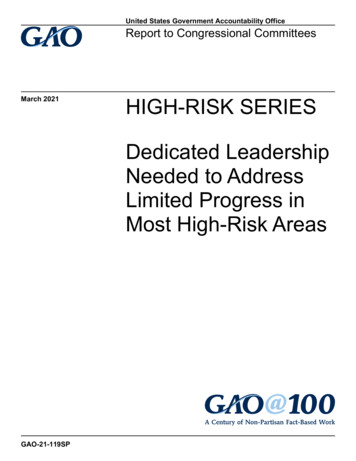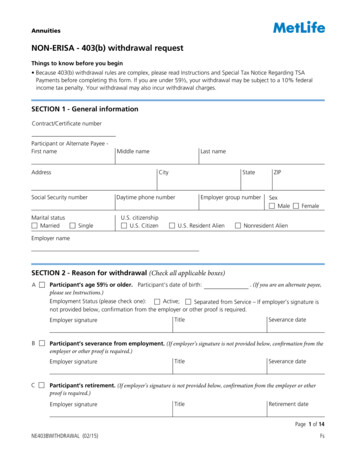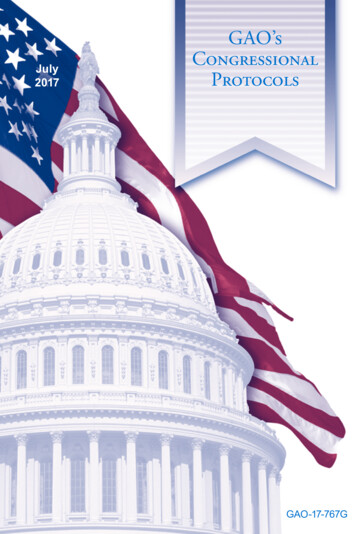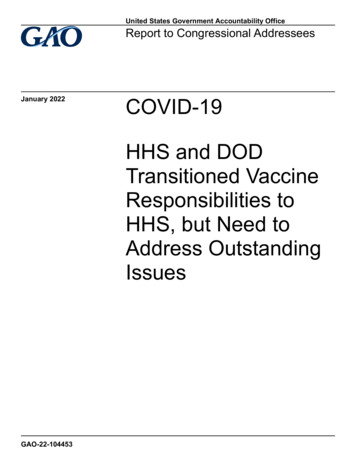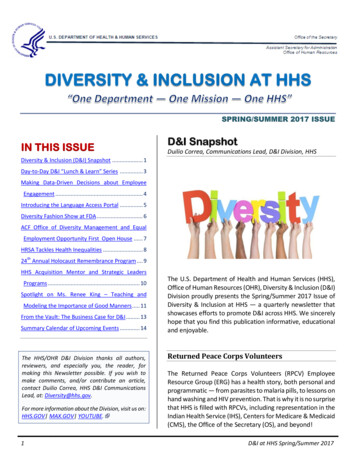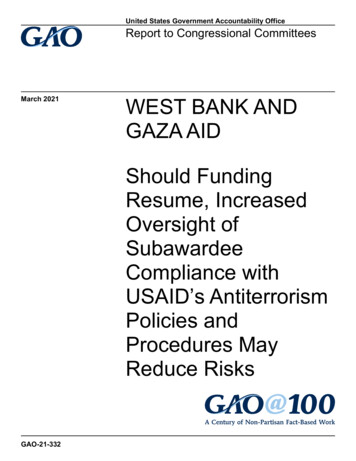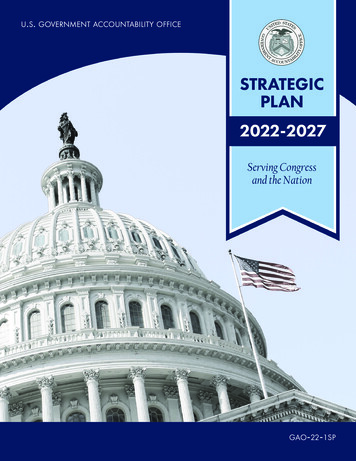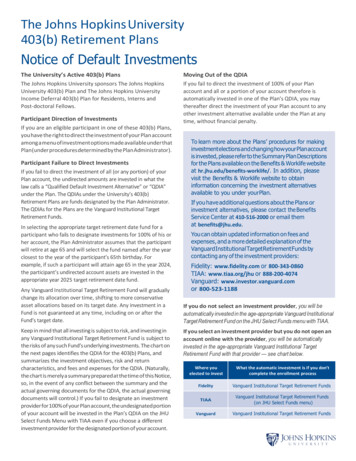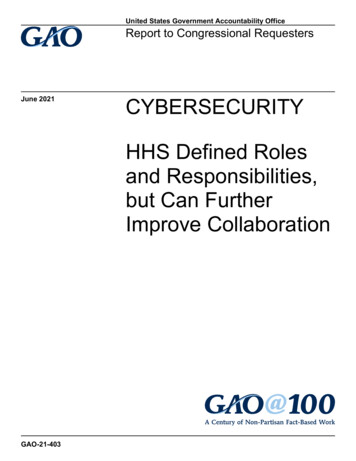
Transcription
United States Government Accountability OfficeReport to Congressional RequestersJune 2021CYBERSECURITYHHS Defined Rolesand Responsibilities,but Can FurtherImprove CollaborationGAO-21-403
June 2021CYBERSECURITYHHS Defined Roles and Responsibilities, but CanFurther Improve CollaborationHighlights of GAO-21-403, a report tocongressional requestersWhy GAO Did This StudyWhat GAO FoundHHS and the healthcare and publichealth sector rely heavily oninformation systems to fulfill theirmissions, including deliveringhealthcare-related services andresponding to national healthemergencies, such as COVID-19.Federal laws and guidance have setrequirements for HHS to addresscybersecurity within the departmentand the sector. Federal guidance alsorequires collaboration and coordinationto strengthen cybersecurity at HHSand in the sector.The Department of Health and Human Services’ (HHS) Office of InformationSecurity is responsible for managing department-wide cybersecurity. HHS clearlydefined responsibilities for the divisions within that office to, among other things,document and implement a cybersecurity program, as required by the FederalInformation Security Modernization Act of 2014.GAO was asked to review HHS’sorganizational approach to addresscybersecurity. This report discussesHHS’s roles and responsibilities fordepartmental cybersecurity; HHS’sroles and responsibilities for healthcareand public health sector cybersecurity;and HHS’s efforts to collaborate tomanage its cybersecurityresponsibilities.To perform its work, GAO revieweddocumentation describing HHS’scybersecurity roles and responsibilities,assessed those responsibilities forfragmentation, duplication, andoverlap, and evaluated thedepartment’s collaborative effortsagainst GAO’s leading practices forcollaboration. GAO also interviewedrelevant officials at HHS and CISA,and in the sector.What GAO RecommendsGAO is making sevenrecommendations to HHS to improveits collaboration and coordinationwithin the department and the sector.HHS agreed with six of therecommendations and disagreed withone. GAO continues to believe that allrecommendations are appropriate.View GAO-21-403. For more information,contact Jennifer R. Franks at (404) 679-1831or franksj@gao.gov.For healthcare and public health critical infrastructure sector cybersecurity, HHSalso defined responsibilities for five HHS entities. Among these entities are theHealth Sector Cybersecurity Coordination Center, which was established toimprove cybersecurity information sharing in the sector, and the HealthcareThreat Operations Center, a federal interagency program co-led by HHS andfocused on, among other things, providing descriptive and actionable cyber data.Private-sector partners that receive information provided by the Health SectorCybersecurity Coordination Center informed GAO that they could benefit fromreceiving more actionable threat information. However, this center does notroutinely receive such information from the Healthcare Threat Operations Center,and therefore is not positioned to provide it to sector partners. This lack ofsharing is due, in part, to HHS not describing coordination between the twoentities in procedures defining their responsibilities for cybersecurity informationsharing. Until HHS formalizes coordination for the two entities, they will continueto miss an opportunity to strengthen information sharing with sector partners.Further, HHS entities led, or participated in, seven collaborative groups thatfocused on cybersecurity in the department and healthcare and public healthsector. These entities regularly collaborated on cyber response efforts andprovided cybersecurity information, guidance, and resources through thesegroups and other means during COVID-19 between March 2020 and December2020. In addition, the HHS entities coordinated with the Department of HomelandSecurity’s Cybersecurity and Infrastructure Security Agency (CISA) to addresscyber threats associated with COVID-19. Further, the HHS entities fullydemonstrated consistency with four of the seven leading collaboration practicesthat GAO identified, and partially addressed the remaining three (see table). UntilHHS takes action to fully demonstrate the remaining three leading practices, itcannot ensure that it is improving cybersecurity within the department and thehealthcare and public health sector.Extent to Which the Department of Health and Human Services (HHS) Demonstrated LeadingPractices for CollaboratingExtent to which the HHS working groupsLeading practicedemonstrated the leading practiceDefine and track outcomes and accountability - five groups met this practiceBridge organizational cultures – all seven groups met this practiceIdentify leadership – all seven groups met this practiceClarify roles and responsibilities - six groups met this practiceInclude relevant participants in the group – all seven groups met this practiceIdentify resources – all seven groups met this practiceDocument and regularly update written guidance and - six groups met this practiceagreementsSource: GAO analysis of HHS documentation. GAO-21-403United States Government Accountability Office
ContentsLetter1BackgroundHHS Has Clearly Defined Roles and Responsibilities for Managingthe Cybersecurity of the DepartmentHHS Clearly Defined Its Roles and Responsibilities for SupportingHPH Sector Cybersecurity; However, Opportunity for ImprovingCoordination ExistsHHS Entities Regularly Shared Cybersecurity Information duringCOVID-19, but Can Further Improve CollaborationConclusionsRecommendations for Executive ActionAgency Comments and Our Evaluation728495051Appendix IObjectives, Scope, and Methodology55Appendix IIDepartment of Health and Human Services’ Cybersecurity-RelatedInformation Sharing Products162261Appendix IIIComments from the Department of Health and Human Services63Appendix IVGAO Contacts and Staff Acknowledgments68TablesTable 1: Responsibilities for the Three Office of InformationSecurity Divisions Managing the Department of Healthand Human Services’ (HHS) Cybersecurity Program, inaccordance with Federal Information SecurityModernization Act of 2014 (FISMA)Table 2: Roles and Responsibilities of the Department of Healthand Human Services (HHS) Entities that ProvideCybersecurity Assistance to the Healthcare and PublicHealth (HPH) Critical Infrastructure SectorTable 3: Roles of the Department of Health and Human Services’(HHS) Cybersecurity-Focused Collaborative GroupsPage i1924GAO-21-403 HHS Cybersecurity
Supporting Cybersecurity Management at the Departmentand Coordination in the Healthcare and Public Health(HPH) SectorTable 4: Examples of Cybersecurity-related Products Shared byDepartment of Health and Human Services (HHS) EntitiesTable 5: Examples of the Department of Health and HumanServices’ Cybersecurity Collaborative Groups’ Actionsthat were Generally Consistent with the Leading Practicesfor CollaborationTable 6: Extent to Which the Department of Health and HumanServices’ Cybersecurity Collaborative GroupsDemonstrated Leading Practices for CollaborationTable 7: Goals of Collaborative Groups led by the HHS Office ofInformation Security and Office of the Assistant Secretaryfor Preparedness and Response (ASPR)Table 8: Information Sharing Products Used by the Department ofHealth and Human Services (HHS) Entities to HelpStrengthen Cybersecurity within the Department andHealthcare and Public Health (HPH) Critical InfrastructureSector61Figure 1: Structure of the Department of Health and HumanServices (HHS) Office of the Chief Information Officer’sOffice of Information Security182933373839FigurePage iiGAO-21-403 HHS Cybersecurity
BIFDAFedRAMPFISMAHC3HHSHIPAAHITECH ActHPHHTOCITNIHNISTOCIOONCPPD 21TRACIEAssistant Secretary for Preparedness and ResponseBiomedical Advanced Research and DevelopmentAuthorityCenters for Disease Control and PreventionCybersecurity and Infrastructure Security AgencyChief Information Security OfficerCoronavirus Disease 2019Computer Security Incident Response CenterDepartment of Homeland SecurityFederal Bureau of InvestigationFood and Drug AdministrationFederal Risk and Authorization Management ProgramFederal Information Security Modernization Act of 2014Health Sector Cybersecurity Coordination CenterDepartment of Health and Human ServicesHealth Insurance Portability and Accountability Act of 1996Health Information Technology for Economic and ClinicalHealth ActHealthcare and Public HealthHealthcare Threat Operations Centerinformation technologyNational Institutes of HealthNational Institute of Standards and TechnologyOffice of the Chief Information OfficerOffice of the National Coordinator for Health InformationTechnologyPresidential Policy Directive 21Technical Resources, Assistance Center, and InformationExchangeThis is a work of the U.S. government and is not subject to copyright protection in theUnited States. The published product may be reproduced and distributed in its entiretywithout further permission from GAO. However, because this work may containcopyrighted images or other material, permission from the copyright holder may benecessary if you wish to reproduce this material separately.Page iiiGAO-21-403 HHS Cybersecurity
Letter441 G St. N.W.Washington, DC 20548June 28, 2021Congressional RequestersThe Department of Health and Human Services (HHS) and theorganizations that make up the Healthcare and Public Health (HPH)critical infrastructure sector rely heavily on information technology (IT)systems to implement their programs and deliver health and healthcarerelated goods and services to the public. 1 For example, HHS currentlyrelies on its HHS Protect platform to provide a holistic view of the U.S.healthcare system to guide the nation’s response to the CoronavirusDisease 2019 (COVID-19). 2 HHS also relies on interconnected ITsystems to make operational decisions on the delivery of health andsocial services. These systems, operated by the department and the HPHsector organizations, process critical sensitive data, such as personallyidentifiable information and protected health information. 31TheCritical Infrastructure Protection Act of 2001 defines “critical infrastructure” assystems and assets, whether physical or virtual, so vital to the United States that theirincapacity or destruction would have a debilitating impact on security, national economicsecurity, national public health or safety, or any combination of these. 42 U.S.C.§5195c(e). In 2003, the federal government established the Healthcare and Public Health(HPH) sector as a critical infrastructure sector in the United States, recognizing that itssecurity and resilience are essential to national security, the economy, and public healthand safety. Since that time, the HPH sector’s partnerships with relevant private sectorowners, operators, and professional associations and government representatives at thefederal, state, and local levels have strengthened.2HHSProtect is a secure data ecosystem that is intended to facilitate the collection,sharing, and analyzing of near real-time COVID-19 data. It integrates information frommore than 200 datasets from federal, state, and local governments and commercialsources.3Personallyidentifiable information is any information that can be used to distinguish ortrace an individual’s identity, such as name, date, place of birth, and Social Securitynumber. It also includes other types of personal information that can be linked to anindividual, such as medical, educational, financial, and employment information. TheHealth Insurance Portability and Accountability Act of 1996 and its implementingregulations define protected health information as individually identifiable healthinformation and includes information collected from an individual, including demographicinformation, that 1) is created or received by a health care provider, health plan, employer,or health care clearinghouse; 2) relates to the past, present, or future physical or mentalhealth condition of the an individual, the provision of health care to an individual, or thepast, present, or future payment for the provision of health care to an individual; and 3)identifies the individual or with respect to which there is a reasonable basis to believe theinformation can be used to identify the individual.Page 1GAO-21-403 HHS Cybersecurity
The Federal Information Security Modernization Act of 2014 (FISMA)directs all federal agencies, including HHS, to ensure the cybersecurity oftheir information and information systems. 4 In addition, Presidential PolicyDirective 21 (PPD 21) requires HHS to lead the coordination ofcybersecurity in the HPH sector. 5 Given the many players involved incybersecurity management at the department and in supporting thecybersecurity of the HPH sector, deliberate and well-organizedcoordination and collaboration are essential to ensure that efforts aresuccessful.Safeguarding federal information systems and those systems supportingour nation’s critical infrastructure has been a longstanding GAO concern.We first designated cybersecurity as a government-wide high-risk area in1997, and expanded the area to include safeguarding the systemssupporting our nation’s critical infrastructure in 2003. 6 We furtherexpanded the cybersecurity high-risk area in 2015 to include protectingthe privacy of personally identifiable information. 7You requested that we review HHS’s organizational structure foraddressing cybersecurity within the department and the HPH sectororganizations. Our specific objectives for this review were to determinethe (1) roles and responsibilities that HHS has defined for its entities tomanage cybersecurity within the department; (2) roles and responsibilitiesthat HHS has defined for its entities to assist the cybersecurity efforts ofHPH sector organizations; and (3) extent to which HHS entities have4TheFederal Information Security Modernization Act of 2014 (FISMA 2014) (Pub. L. No.113-283, Dec. 18, 2014) largely superseded the Federal Information SecurityManagement Act of 2002 (FISMA 2002), enacted as Title III, E-Government Act of 2002,Pub. L. No. 107-347, 116 Stat. 2899, 2946 (Dec. 17, 2002). As used in this report, FISMArefers both to FISMA 2014 and to those provisions of FISMA 2002 that were eitherincorporated into FISMA 2014 or were unchanged and continue in full force and effect.5WhiteHouse, Presidential Policy Directive 21 (PPD 21), Critical Infrastructure Securityand Resilience (Feb. 12, 2013).6GAO,High-Risk Series: An Overview, GAO-HR-97-1 (Washington, D.C.: February 1997);High-Risk Series: Information Management and Technology, GAO-HR-97-9 (Washington,D.C.: February 1997); and High-Risk Series: An Update, GAO-03-119 (Washington, D.C.:Jan. 2003).7GAO,High-Risk Series: An Update, GAO-15-290 (Washington, D.C.: Feb. 11, 2015). Forour most recent update on this high-risk area see High-Risk Series: Dedicated LeadershipNeeded to Address Limited Progress in Most High-Risk Areas, GAO-21-119SP(Washington, D.C.: Mar. 2, 2021).Page 2GAO-21-403 HHS Cybersecurity
effectively collaborated to manage their cybersecurity responsibilities,including COVID-19 cyber response efforts.To address the first and second objectives, we considered a key principleof an effective control environment on management establishing anorganizational structure, assigning responsibility, and delegating authorityto achieve the entity’s objectives. 8 To determine how HHS determined itsentities’ roles and responsibilities to meet its cybersecurity objectives, weanalyzed relevant HHS documentation, such as organizational charts, forthe full department, as well as for the Office of the Chief InformationOfficer (OCIO), Office of the Assistant Secretary for Preparedness andResponse (ASPR), and Office of the National Coordinator for Health IT;departmental cybersecurity-related policies and procedures; strategic andoperational plans; and HPH sector plans.In reviewing these documents, we identified the HHS entities (e.g.,offices, divisions, or centers) that had been assigned roles for managingcybersecurity within the department and for assisting with cybersecurityefforts in the HPH sector. We also reviewed HHS cybersecurity policiesand procedures and strategic and operational plans, as well as HPHsector plans, to identify the responsibilities required to carry out theidentified roles. We assessed the roles and responsibilities of the entitiesin comparison to the eight FISMA-defined elements of a cybersecurityprogram (discussed later in this report), and federal requirements relatedto cybersecurity in the HPH sector.In addition, we used the steps recommended by GAO’s fragmentation,overlap, and duplication evaluation guide to identify whether there wasany fragmentation, overlap, or duplication in the responsibilities of theentities we identified with roles in cybersecurity. 9 Specifically, weanalyzed HHS documentation describing the entities’ cybersecurityresponsibilities to determine the: entities’ goals and outcomes; entities’ defined roles and responsibilities; relationships among the entities;8GAO,Standards for Internal Control in the Federal Government, GAO-14-704G(Washington, D.C.: Sept. 10, 2014).9GAO, Fragmentation, Overlap, and Duplication: An Evaluation and Management Guide,GAO-15-49SP (Washington, D.C.: Apr. 14, 2015).Page 3GAO-21-403 HHS Cybersecurity
effects of any identified fragmentation, overlap, or duplication in theentities’ roles and responsibilities; and means by which the entities could increase efficiency and reduce orbetter manage the fragmentation, overlap, or duplication.Further, we interviewed senior officials in HHS’s OCIO, ASPR, and theOffice of the National Coordinator for Health IT to verify that the HHSentities we identified had significant roles in managing the department’scybersecurity and in assisting the HPH sector with cybersecurity. We alsodiscussed these officials’ responsibilities for fulfilling those roles.To address the third objective, we assessed control activities related totwo key internal control principles that management should design controlactivities to achieve objectives and respond to risks, and implementcontrol activities through the policies. 10 Specifically, we assessed thedepartment’s efforts to use collaboration to manage its cybersecurityresponsibilities by reviewing documentation of the management andoperations of collaborative groups involved in addressing cybersecuritywithin the department and HPH sector.To do this, we identified the groups that the HHS entities told us theyused for cybersecurity collaboration within the department and HPHsector. We then selected for review, the seven cybersecurity-focusedgroups for which the HHS entities maintained operational documentation(i.e., charters and concepts of operation). 11 These collaborative groupswere the HHS Chief Information Security Officer Council HHS Cloud Security Working Group HHS Continuous Monitoring and Risk Scoring Working Group10GAO-14-704G11HHS officials in OCIO’s Office of Information Security informed us that there are severalworking groups chartered under the Chief Information Security Officer Council. Thoseworking groups include the Federal Information Security Modernization Act and theCybersecurity Awareness, Training, and Education working groups. In addition, the sixHHS operating divisions that we selected for this review informed us of othercybersecurity-related working groups, such as the HHS Incident Response Team, HHS ITStrategic Workforce, HHS Cybersecurity Workforce Development, Cyber ThreatCoordination working groups, and others. However, the officials in the Office ofInformation Security did not provide charters or other documentation describing theoperation of these working groups.Page 4GAO-21-403 HHS Cybersecurity
Healthcare Threat Operations Center HHS Cybersecurity Working Group HPH Sector Government Coordinating Council’s CybersecurityWorking Group Joint HPH Cyber Working GroupWe reviewed charters and concepts of operation for these collaborativegroups to assess the management and operation of each group againstseven leading collaboration practices that were identified in our priorwork. 12 Those practices were: Outcomes and accountability address whether short- and long-termoutcomes have been clearly defined, and the extent tracking andmonitoring of progress in achieving outcomes has been performed. Bridging organizational cultures includes identifying the missionsand cultures of the participating organizations in the collaborativegroups. Leadership involves designating an individual who will lead thecollaborative groups. Clarity of roles and responsibilities addresses whether thecollaborative groups have clarified roles and responsibilities. Participants includes ensuring that all relevant participants areinvolved in the collaborative groups. Resources involves leveraging relevant staff and IT resources tosupport the operations of the collaborative groups. Written guidance and agreements includes documenting thecollaborative groups’ agreement regarding how they will collaborateand determining ways to continually update and monitor theseagreements.To further evaluate the effectiveness of the HHS entities’ collaborativeefforts as part of the third objective, we assessed the entities’ informationsharing processes as they pertain to three key principles of internalcontrol information and communication activities: that managementshould use quality information to achieve the entity’s objectives; internally12GAO,Results-Oriented Government: Practices That Can Help Enhance and SustainCollaboration among Federal Agencies, GAO-06-15 (Washington, D.C.: Oct. 21, 2005)and Managing for Results: Key Considerations for Implementing Interagency CollaborativeMechanisms, GAO-12-1022 (Washington, D.C.: Sept. 27, 2012).Page 5GAO-21-403 HHS Cybersecurity
communicate the necessary quality information to achieve the entity’sobjectives; and externally communicate the necessary quality informationto achieve the entity’s objectives. 13 Specifically, we obtaineddocumentation, such as flow charts and standard operating procedures,and interviewed senior officials to identify the processes used by the HHSentities to share cybersecurity information. We then compared the HHSentities’ information sharing processes to the internal control standardsthat recommend management to identify relevant information fromreliable sources to make informed decisions and address risks;communicate necessary quality information internally and externally; anduse appropriate methods of communication for internal and externalinformation sharing.We supplemented our analyses by interviewing senior officials from theHHS OCIO, ASPR, and Office of the National Coordinator for Health IT.We obtained information on any challenges they had identified incollaborating with relevant sector partners to implement their roles andresponsibilities for department and HPH sector cybersecurity.Further, we interviewed officials charged with leading cybersecurity effortsin six HHS operating divisions. We obtained these officials’ perspectiveson the HHS entities’ efforts to implement their roles and responsibilitiesfor managing the department-wide cybersecurity program through itscollaborative measures.We selected the six operating divisions based on the number and type ofinformation systems they operate (i.e., low-, moderate-, and highimpact), 14 as reported in HHS’s fiscal year 2019 FISMA report. The sixoperating divisions selected were the Food and Drug Administration13GAO-14-704G14Information systems are categorized according to the magnitude of harm or impactresulting from the system or its information being compromised. The Standards forSecurity Categorization of Federal Information and Information Systems define threeimpact levels where the loss of confidentiality, integrity, or availability could be expected tohave a limited adverse effect (low), a serious adverse effect (moderate), or a severe orcatastrophic adverse effect (high) on organizational operations, organizational assets, orindividuals. Federal Information Processing Standards Publication 199, Standards forSecurity Categorization of Federal Information and Information Systems (Gaithersburg,Md.: February 2004).Page 6GAO-21-403 HHS Cybersecurity
Centers for Medicare and Medicaid Services Centers for Disease Control and Prevention (CDC) Health Resource and Services Administration Substance Abuse and Mental Health Services Administration Agency for Health Research and QualityWe also interviewed the HPH Sector Coordinating Council’s ExecutiveDirector for Cybersecurity to obtain information on relevant HHS entities’efforts to collaborate with private sector partners to implement their rolesand responsibilities for HPH sector cybersecurity. 15 Lastly, we interviewedsenior officials at the Department of Homeland Security’s (DHS)Cybersecurity and Infrastructure Security Agency (CISA) to obtaininformation and documentation on their efforts to coordinate with HHS toshare cybersecurity information and resources with the HPH sector. Amore detailed description of our objectives, scope, and methodology canbe found in appendix I.We conducted this performance audit from November 2019 to June 2021in accordance with generally accepted government auditing standards.Those standards require that we plan and perform the audit to obtainsufficient, appropriate evidence to provide a reasonable basis for ourfindings and conclusions based on our audit objectives. We believe thatthe evidence obtained provides a reasonable basis for our findings andconclusions based on our audit objectives.BackgroundHHS’s mission is to enhance the health and well-being of Americans byproviding for effective health and human services and fostering advancesin the science underlying medicine, public health, and social services.The department is made up of several components that support thefulfillment of its mission. For example, the National Institutes of Health’s(NIH) mission is to seek knowledge about the nature and behavior ofliving systems and apply that knowledge to enhance health, lengthen life,and reduce illness and disability. Additionally, the CDC is responsible forleading national efforts to detect, respond to, and prevent illnesses and15Thereare 16 critical infrastructure sectors that each have a sector coordinating councilthat consists of private organizations and functions as the principal entryway for thegovernment to collaborate with each sector. Examples of private organizations in the HPHsector include medical facilities, health insurance companies, medical equipment andsupply manufacturers, and pharmacies.Page 7GAO-21-403 HHS Cybersecurity
injuries that result from natural causes or the release of biological,chemical, or radiological agents.Given HHS’s knowledge and expertise in providing healthcare andimproving public health, it serves as the lead federal agency responsiblefor coordinating security and resilience efforts for the HPH sector. TheHPH sector provides services that are essential to maintaining local,national, and global health security. The organizations that make up thesector specifically include direct patient care facilities, health informationtechnology vendors, health insurance companies, mass fatalitymanagement services, medical supply and equipment manufacturers,and laboratories and pharmacies.HHS and the HPH SectorHave Been the Target ofMalicious Cyber ActivityHPH sector organizations have been the targets for malicious cyberactivity for the past 10 years. Most recently, COVID-19 has highlightedthe need for HHS to pay continuous attention to cyber threats, which posea serious challenge to national security, economic well-being, and publichealth and safety. Since the start of the nation’s response to COVID-19 inMarch 2020, HHS and the HPH sector organizations have been targetsfor malicious cyber activity.The following examples of incidents and alerts illustrate how the actionsby malicious actors have targeted patient information, intellectualproperty, public health data, and intelligence. Specifically, In March 2020, HHS was the target of a distributed denial-of-servicecyberattack. 16 The former Secretary of HHS reported that no datawere breached and the agency’s operations were not impacted.Nevertheless, during a May 2020 meeting with officials from thedepartment’s OCIO, the former Chief Information Officer informed usthat HHS had been targeted daily with sophisticated cyberattackssince March 15, 2020. In May 2020, CISA released a joint alert with the United Kingdom’sNational Cyber Security Centre regarding advanced persistent threatgroups exploiting COVID-19 to target healthcare and essential16Adistributed denial-of-service attack uses traffic generated from many different sourcesto create a high-volume of traffic directed toward an intended target, resulting indisruptions and damages.Page 8GAO-21-403 HHS Cybersecurity
services. 17 The alert warned that advanced persistent threat groupswere frequently targeting organizations in order to collect bulkpersonal information, intellectual property, and intelligence that alignswith national priorities. In May 2020, CISA and the Federal Bureau of Investigation (FBI)issued a joint public service announcement to raise awareness of athreat to COVID-19-related research. 18 The announcement stated thatcyber actors associated with the People’s Republic of China had beenobserved attempting to identify and obtain valuable intellectualproperty and public health data related to vaccines, treatments, andtesting from networks and personnel affiliated with COVID-19-relatedresearch. As a result, the FBI and CISA urged organizationsconducting research in these areas to maintain cybersecuritypractices to prevent surreptitious review or theft of COVID-19-relatedmaterial. In October 2020, CISA, the FBI, and HHS issu
The Department of Health and Human Services' (HHS) Office of Information Security is responsible for managing department-wide cybersecurity. HHS clearly defined responsibilities for the divisions within that office to, among other things, document and implement a cybersecurity program, as required by the . Federal
